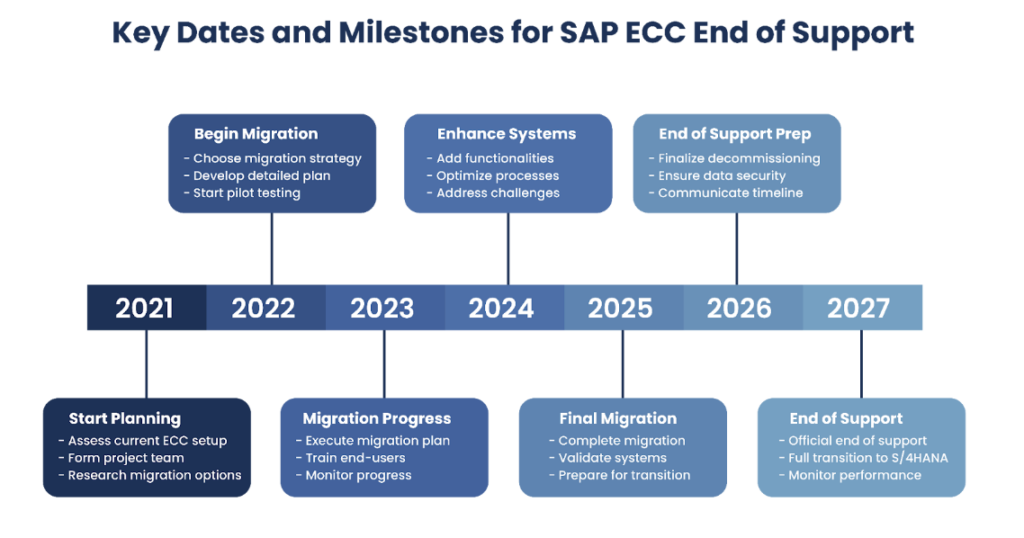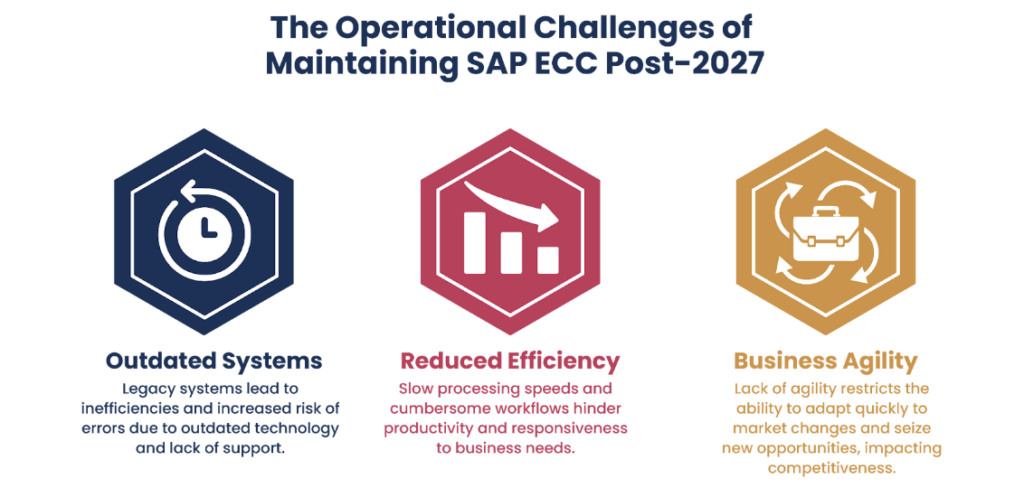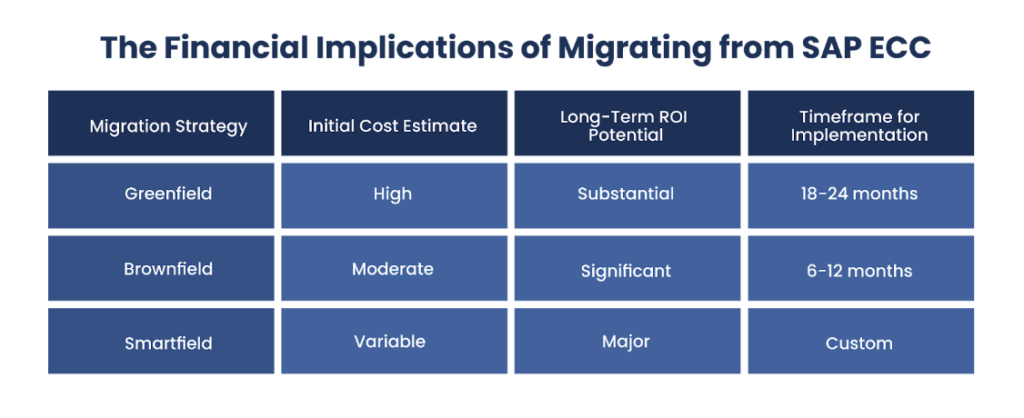Preparing for SAP ECC End of Support in 2027: Strategies and Solutions
 23 May 2024
23 May 2024? Listen to the Summary of this article in Audio
As 2027 marks the pivotal SAP ECC end of support, an urgent pivot within the landscape of enterprise technology is imminent. The cessation of updates and security patches for SAP ECC not only signals an end but heralds a transformational beginning—a call to enterprise technology transformation. Forward-thinking organizations are now tasked with crafting robust business transition strategies to migrate to advanced systems like SAP S/4HANA. The shift is more than a mere IT upgrade; it’s a stratagem, crucial to sustaining competitive advantage and catalyzing growth in a future-driven market.
The momentum for this shift is gaining, as enterprises seek not only to preserve the continuity of their operations but also to unlock new avenues of innovation and efficiency. With the SAP ECC end of support 2027 approaching, businesses are at a crossroads, where choosing the path of technology evolution will shape their future for decades to come.
Key Takeaways
- Approaching the end of mainstream maintenance, SAP ECC will become a legacy system by 2027, necessitating proactive migration measures.
- Transitioning to SAP S/4HANA presents opportunities for enterprise technology transformation, critical for modern business operations.
- Effective business transition strategies will minimize disruption and maximize the benefits of new systems, assuring continuous innovation.
- Ensuring data integrity and compliance, post-2027, is paramount, with the added advantage of leveraging AI and IoT in process optimization.
- Preparation now determines future success, with the closing window before SAP ECC end of support serving as a catalyst for change.
Introduction to SAP ECC and Its Evolution
The emergence of SAP ECC (SAP ERP Central Component) marked a significant milestone in enterprise resource planning systems, establishing a foundation for business operations worldwide. This robust software suite has been instrumental in integrating various business functions, facilitating a tremendous leap in operational efficiency and data management. However, with the timeline for the end of mainstream maintenance drawing closer, the narrative surrounding SAP ECC is rapidly shifting towards migration urgency and the vital need for transformation.
Understanding the Implications of SAP ECC End of Support
As we edge towards 2027, the pivot from SAP ECC must be understood not as merely a technological shift but as a strategic imperative. Organizations that have long depended on SAP ECC are now at a crucial juncture. The looming end of support deadline signifies more than just a discontinuation of updates; it heralds the advent of potential vulnerabilities and operational stasis. Consequently, there is a pressing requirement to transition to advanced platforms like SAP S/4HANA—that epitomize the SAP ECC evolution, offering real-time analytics, agility, and the ability to drive transformative Industry 4.0-compliant business practices.
Key Dates and Milestones for SAP ECC End of Support
The countdown to the end of support for SAP ECC zeroes in on vital milestones leading up to 2027. This timetable is not merely a series of dates but a sequence of strategic opportunities for businesses to align their migration projects with organizational objectives. The migration to SAP S/4HANA embodies this generational change—marking a significant moment for organizations to elevate their operational paradigms to meet future challenges and opportunities head-on.

The Impact of SAP ECC End of Support on Businesses
The impending end of support for SAP ECC signifies a critical shift for businesses reliant on this system. In analyzing the SAP ECC migration impact, a holistic view reveals a landscape of challenges and essential considerations, encompassing operational efficacy, compliance adherence, and the fiscal aspects of transitioning to SAP S/4HANA. It’s clear that the migration period is not just a technical hurdle, but a strategic juncture that will define future business terrain.
Operational Challenges
As the 2027 deadline approaches, the echoes of outdated systems become operational challenges hindering businesses. Legacy SAP ECC systems may have sufficed for previous demands, but their dwindling support threatens to curtail operational efficiency and forestall business agility. Companies face the daunting task of overhauling their ERP landscapes—a journey fraught with potential for disruption, yet rich with opportunity for modernization.

Compliance and Security Risks
The termination of updates for SAP ECC exposes enterprises to compliance issues and security risks. As regular updates and security patches cease, vulnerabilities remain unchecked, leaving critical systems open to threats. The risk to data integrity magnifies, not just as a technicality but as a potential menace to overall business continuity and reputation. Consequently, the migration to SAP S/4HANA emerges as more than an upgrade—it becomes a mandatory leap towards safeguarding assets and ensuring compliance in a digitized economy.
The Financial Implications of Migrating from SAP ECC
When considering the migration costs, businesses confront varied financial landscapes depending on the chosen route—Greenfield, Brownfield, or Smartfield. While each strategy incurs its unique expenses, all promise the prospect of long-term operational savings and efficiencies enabled by SAP S/4HANA. This comparative table underscores the financial nuances of each approach and its implications on the overall investment in business transformation.

The table illustrates the contrasts among the three prevailing strategies. While the initial investment might appear daunting, particularly for the Greenfield approach, the progressive realization of ROI underscores a strategic advantage. In the migration calculus, foresight is quintessential—weighing up-front migration costs against the sustained operational and strategic rewards SAP S/4HANA offers.
Preparing for the Transition: Strategies and Best Practices
As the end of SAP ECC support inches closer, strategizing the transition to SAP S/4HANA or other suitable systems becomes critical for continued operational efficiency and business agility. Migration is no small feat; it requires in-depth evaluation, meticulous planning, and a commitment to upskilling the workforce. Addressing the complexity of this transition requires a structured approach that ensures a seamless migration and positions the enterprise for technology leadership in the future.
Evaluating Migration Paths: SAP S/4HANA, Alternatives, and Custom Solutions
Organizations must meticulously assess the migration paths available. Selective Data Transition, Greenfield, and Brownfield pathways each offer distinctive advantages and challenges. A Selective Data Transition facilitates a tailored approach, merging the benefits of the Greenfield and Brownfield methods. It allows businesses to selectively migrate data and processes, ensuring a balanced migration that aligns with individual business needs. Considering alternatives or custom solutions is also imperative, as these can provide the flexibility required by certain facets of businesses with highly specialized needs.
Building a Comprehensive Migration Plan
Comprehensive migration planning is foundational for a successful transition. It encompasses a wide array of elements such as project scope, timeline establishment, resource allocation, and meticulous data migration strategies. Additionally, this plan must address process optimization to align with the new system’s capabilities and manage integration complexities that could arise from legacy systems to SAP S/4HANA interfaces. Executing a comprehensive migration plan is a dynamic process that demands constant adjustment and alignment with the organization’s strategic objectives.
Training and Resources for a Smooth Transition
The transformation does not stand solely on system changes but also hinges on workforce upskilling. Training programs and resources are essential to equip personnel with the requisite skills for handling the technological advancements inherent in SAP S/4HANA. Workforce upskilling not only fosters system proficiency but also instills confidence in the staff, which is vital for embracing new workflows and technologies. This human-centric component of the migration reflects the need for a change management strategy that underlines the value of a capable and agile workforce.
Thorough planning and execution capabilities are the linchpins of a successful transition from SAP ECC to SAP S/4HANA or its alternatives. By evaluating the various migration pathways, building a comprehensive plan, and dedicating resources to workforce upskilling, enterprises can not only navigate this complex transition but thrive in its aftermath.
Exploring Custom Solutions as a Strategic Alternative
For many enterprises, the standard migration route to SAP S/4HANA might not align with the strategic direction or specific operational needs of the business. In such instances, exploring the avenue of custom ERP solutions can provide a powerful strategic enterprise alternative. These tailored systems are designed from the ground up to integrate seamlessly with existing IT infrastructure, offer greater flexibility, and closely match the unique processes of a company.
The Advantages of Developing a Custom Solution
Custom ERP solutions enable organizations to transcend the constraints of off-the-shelf software, offering the agility to respond swiftly to market changes and internal demands. The customization of ERP systems can occupy a range of modifications from minor feature enhancements to the development of entirely new modules that reflect the company’s workflow and industry specifics. This degree of personalization ensures that the software evolves in tandem with the business, potentially introducing a competitive edge and increased productivity.
Key Considerations When Building a Custom Solution
When venturing into the territory of custom ERP solutions, companies need to critically evaluate several factors. The complexity of customization should be considered in terms of both the initial development and long-term scalability. Compatibility with current systems is crucial to ensure a smooth transition and continual operation. Moreover, there must be a sustainable plan for maintenance and future updates, to ensure that the solution remains robust against the evolving technological landscape.
Integrating Custom Solutions with Existing IT Infrastructure
IT infrastructure integration stands as one of the most critical aspects of deploying custom ERP solutions. Strategic enterprise alternatives such as these must not only enhance current operations but also integrate without friction into the existing technological environment. This means adherence to data standards, ensuring secure connectivity, and providing scalability options. Thorough planning and collaboration with IT specialists are essential to achieving a seamless integration that drives business growth and efficiency.
Discover the power of custom ERP systems designed to seamlessly integrate with your unique processes and drive innovation within your organization.
Case Studies: Successful Migrations and Transformations
The insights and successes from corporations that effectively transitioned from SAP ECC to S/4HANA echo the transformative power of diligent planning and execution. These case studies not only exemplify strategic pivots but also present themselves as a canvas of inspiration for continuous innovation after an upgrade.
Lessons Learned from Early Adopters
Early adopters of S/4HANA provide real-world insights that showcase the value brought about by the transformation. Aggregated from diverse industries, these pioneers observed several critical success factors. Most prominently, these included the importance of executive sponsorship, comprehensive stakeholder engagement, and an unwavering focus on addressing business requirements in concert with technology change. They report measurable benefits in the form of improved process efficiencies, enhanced data quality, and elevated decision-making capabilities—benefits that only crystallized when accompanied by an inclusive change management approach.
How Businesses Can Innovate Post Migration
Following the migration, businesses have identified numerous opportunities for innovation, leveraging the advanced functionalities inherent in S/4HANA. Case studies highlight the ability to embed analytics directly into operational processes, resulting in actionable insights that can lead to improved outcomes across all business functions. The upgrade is cited as a catalyst for innovation, with organizations utilizing S/4HANA’s real-time processing to introduce new business models and enter untouched markets, setting a new precedent for agility and competitiveness in the digital era.
In conclusion, these enterprise journeys stand testament to the potential that lies beyond an SAP ECC to S/4HANA migration. They frame a narrative of not only overcoming challenges but also unlocking a new world of possibilities in business process excellence and innovation.
Conclusion: Embracing Change and Preparing for the Future
The approaching end of support for SAP ECC represents a pivotal moment for enterprises grappling with the strategic implications of their technology infrastructure. This period of transformation is an opportunity to embrace change with vigor and to harness the inherent potential of advanced enterprise technology adaptation. As organizations delineate their SAP migration conclusion, it is essential to recognize that the journey to SAP S/4HANA or alternative ERP solutions is not merely a transitional hurdle, but rather a calculated leap towards a digitized, interconnected, and innovative business landscape.
Preparing for this transition demands more than cursory adjustments; it entails a future-focused mindset and an unwavering commitment to reshaping the enterprise ecosystem for longevity and resilience. The crux of a successful migration hinges on a strategic synthesis of judicious planning, an expansive understanding of both the benefits and the inevitable risks, and empowering the organization through inclusivity and informed decision-making. An astute awareness of future enterprise technology adaptation as an ongoing process is imperative, ensuring that the evolution toward SAP S/4HANA enhances global competitiveness and propels businesses into a thriving digital economy.
In closing, as the horizon of SAP ECC end of support draws near, organizations are beckoned to redefine their core operational capabilities and invest in a future-proof business environment. This juncture is not only a call to adopt new technology but to cultivate a culture of innovation and agility—a culture primed to embrace the winds of change in the constant pursuit of excellence. Proactivity in this critical phase will solidify an organization’s position as a digital economy frontrunner, poised to exploit the full spectrum of opportunities that lie beyond the realm of traditional ERP systems.
Partner with our experienced team to navigate the complexities of enterprise technology adaptation and position your business for long-term success in the digital economy.
FAQ
What Happens If You Don’t Migrate Before the End of Support?
Organizations that don’t migrate before the SAP ECC end of support in 2027 will no longer receive updates or security patches, leading to increased security risks, compliance issues, and operational inefficiencies. Businesses will face challenges in maintaining data integrity, and troubleshooting support will be limited, potentially resulting in business disruptions.
Can You Stay on SAP ECC Without Support and What Are the Risks?
It is technically possible to continue using SAP ECC without support, but doing so poses significant risks. These risks include vulnerabilities to cyber threats due to lack of security updates, non-compliance with new regulations, and potential compatibility issues with other evolving technologies. This can lead to costly consequences and may harm the organization’s reputation and operations.
How Long Does a Typical Migration to SAP S/4HANA or a Custom Solution Take?
The timeline for a migration to SAP S/4HANA or a custom solution varies based on the size of the organization, complexity of the current system, and the chosen migration strategy. Typically, it can take anywhere from 6 to 24 months. The process involves comprehensive planning, testing, data migration, and training, which should be carefully orchestrated to minimize downtime and disruption.
What Are the First Steps in Planning for SAP ECC Migration?
The first steps in planning for SAP ECC migration include conducting a thorough assessment of your current IT landscape and business processes, defining a clear business case for the migration, deciding on a migration strategy (Greenfield, Brownfield, or Selective Data Transition), evaluating potential cloud hosting options, and considering the integration compatibility of existing data and applications.
Source Links
- https://www.linkedin.com/pulse/navigating-transition-from-sap-ecc-s4-strategies-analysis-viney-hora
- https://www.linkedin.com/pulse/navigating-sap-s4hana-migration-maze-challenges-stefan-holitschke-nqnhe?trk=public_post
- https://www.grantthornton.co.uk/insights/sap-ecc-end-of-life-secrets-of-a-successful-transition/










